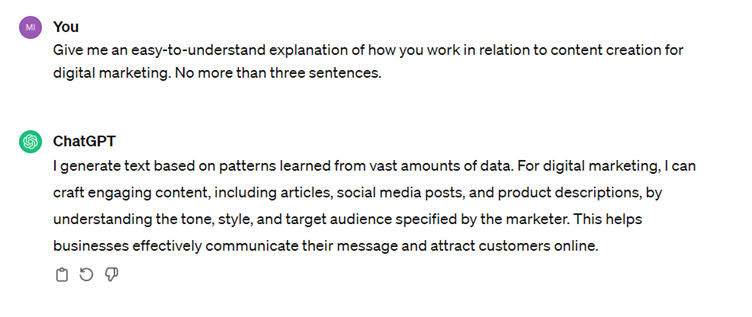The digital world never stands still – especially when it comes to getting your business noticed online. For any forward-thinking business owner or marketing manager, knowing what's just around the corner in the world of digital marketing can make all the difference.
Here at SQ Digital, we keep our finger on the pulse of the latest trends to make sure our clients are always one step ahead.
Ready for a sneak peek into the future? Let's explore the top trends that will dominate digital marketing over the next year – giving you the edge you need to keep your business one step ahead of the competition.
- SEO Trends
- Content Marketing Trends
- Organic Social Media Trends
- Paid Social Media Trends
- PPC Trends
- Web Design Trends
- 2024 Digital Marketing Trends: Summary
SEO Trends
Search Engine Optimisation (SEO) is always evolving, but several key trends are shaping the future of digital marketing strategies. From the impending rollout of Search Generative Experience (SGE) to the critical role of Experience, Expertise, Authoritativeness, and Trustworthiness (EEAT), businesses will need to adapt in order to stay relevant and maintain visibility online. Also, with the continued rise of zero-click searches and the need for businesses to focus on getting the most out of their SEO efforts to improve Return on Investment (ROI), there’s a lot to consider when it comes to SEO. Let's look into these trends and what they mean for digital marketers and businesses trying to stay relevant in an increasingly competitive space.
Search Generative Experience (SGE)
In the world of SEO, one emerging concept promises to revolutionise the ways in which businesses interact with search engines. This innovation, known as Search Generative Experience (SGE) or Generative Search, has the potential to dramatically change how users interact with search engines, impacting the effectiveness of search results.
Understanding the Search-Generative Experience?
SGE pairs traditional search algorithms with advanced machine learning, or AI, to create a responsive, customisable search experience. As opposed to conventional search, where results are defined solely by the algorithm of the search engine (Google, for example), SGE factors user behaviour, preferences, and intention into the search matrix, creating a unique and highly personalised search experience for each user. If that all sounds a bit complicated, this video from Google should help to clarify what SGE is and how it's set to fundamentally change how we search online:
What does this mean for digital marketers and businesses?
With the introduction of Search Generative Experience (SGE) in May 2023 and its upcoming full launch in Q2 - Q3 of 2024, the digital marketing landscape is on the brink of a major change. Businesses will need to transition from traditional keyword optimisation strategies to a deeper, more nuanced understanding of user behaviour patterns and preferences for search personalisation.
For digital marketers and businesses, it's more crucial than ever to put users first in SEO. This means focusing on audience segmentation and creating personalised content that matches their interests and behaviours. Also, optimising websites for mobile and voice search, improving site speed, and prioritising user experience are essential for better SGE performance. As SGE evolves, developing a personalised and trustworthy online presence and engaging with users will become even more important to boost a website's credibility and performance in a search environment optimised for SGE.
The Crucial Role of EEAT in SEO Strategy
Google’s EEAT framework has become an essential factor for SEO. It's a key element that affects how well a website performs; in simple terms, it means that high-quality content made by trusted experts ranks higher in search results.
What Does EEAT Mean for SEO and Content Marketers
Content marketers need to understand the impact that EEAT principles have on a business's online visibility, which means breaking down what each principle means in order to create SEO strategies that deliver tangible results.
Here's what marketers need to focus on when applying EEAT principles:
- Experience: Content should come from someone with direct knowledge of the topic, providing real examples and personal insights.
- Expertise: Ensure content is created by knowledgeable individuals, showcasing qualifications or background in the subject.
- Authoritativeness: Build a strong reputation as an authority in the field, being cited by reputable sources.
- Trustworthiness: Deliver accurate, truthful content with transparency, citing reliable sources and ensuring secure user interaction.
For content marketers, EEAT is a blueprint for creating high-quality content that can rank well on Google. Following these guidelines can improve a site's visibility and authority in search engine results, attracting a larger audience and building greater trust with users.
Prioritising User Intent in Keyword Optimisation
In today’s complex SEO landscape, simply integrating popular keywords into content isn't enough to secure top rankings on search engine results pages (SERPs). The evolution of search algorithms and the impeding SGE rollout demands a more nuanced approach—one that prioritises user intent in keyword optimisation. Understanding the why behind a search query is critical, especially with the rise of zero-click searches and the need to drive meaningful engagement and conversions.
Adapting to Zero Click Searches
Zero-click searches are where answers are directly provided on the SERP itself (in snippets, knowledge boxes, etc.). It means users no longer need to click through to a website to find the information they’re looking for. This also includes SGE, as we talked about earlier, and its ability to generate highly relevant, personalised content directly on the SERPs.
By optimising content to be featured in rich snippets or answer boxes and addressing specific questions, businesses can capture visibility even in a zero-click environment, ensuring their information stands out in the increasingly dynamic and competitive SERP landscape.
Strategies for Identifying and Targeting User Intent
To effectively target user intent, you need to understand your audience's search context and behaviour. This can be done by:
- Analysing Keyword Intent: Categorise keywords by intent (like informational or transactional) to tailor content for each user stage.
- Studying SERP Results: Review current search results to understand the content that ranks well for target keywords.
- Gathering Audience Insights: Use analytics and feedback tools to understand how visitors engage with your site to learn more about their preferences.
Once you've identified user intent, the next move is to use these insights to refine your content strategy. Next, we’ll talk about how to translate this knowledge into action.
Maximising ROI through Intent-Driven SEO Efforts
Aligning SEO practices with user intent not only improves rankings and visibility but also significantly enhances the ROI of SEO campaigns. When content fulfils the actual needs of the searcher, it leads to increased engagement, lower bounce rates, and higher conversion rates. Intent-driven keyword optimisation means attracting more qualified traffic—visitors who are actively seeking what you offer and are, therefore, more likely to convert.
- Content Customisation: For each category of intent you've identified, design specific content that matches. For informational intent, create educational blogs, guides, or how-to videos. For transactional intent, focus on product comparisons, detailed feature benefits, or offer pages.
- User Experience (UX) Optimisation: Ensuring a seamless and satisfying user experience is vital in converting intent-driven traffic into conversions. Site navigation, mobile-friendliness, and page load speed are all factors that influence the effectiveness of your intent-optimised content.
- Conversion Rate Optimisation (CRO): Apply the data you gather from user intent analysis to optimise conversion paths on your website. Simplify the journey from landing on a page to completing a conversion action, removing friction points and making it intuitive for users to get to where they want to be.
- Keyword Optimisation: Integrate the keywords aligned with different user intents into your content, titles, meta descriptions, and URLs. This boosts SEO and makes it easier for users to find content that matches their search intent.
- User Journey Mapping: Outline the path a user takes from first landing on your site to completing a desired action, like a purchase or sign-up. Tailor content at each stage to guide them smoothly along this journey.
- Feedback Loop Creation: Continuously collect and analyse user feedback and website engagement metrics to see if the content is effectively meeting the intended audience's needs. Use tools like surveys, comment sections, and analytics to gauge satisfaction and adjust strategies accordingly.
- SERP Feature Targeting: Aim to get your content featured in SERP features like featured snippets or "People also ask" sections for relevant queries. This increases visibility for users with specific intents and can significantly drive traffic while also working to align with the rising trend toward zero-click search.
By focusing on user intent in keyword optimisation and adjusting to changes in search trends, SEO efforts can increase ROI. This strategy not only meets users' immediate needs but also helps achieve your business goals, making it beneficial for both users and businesses in the competitive SEO landscape.
Content Marketing Trends
Content marketing is changing faster than ever before, driven by technology and how people behave online. We’ll look at four major trends shaping content strategies in 2024: AI in content creation, the impact of voice search, the importance of long-form content for SEO, and advanced personalisation. These changes bring both opportunities and challenges for marketers striving to lead in the content world.
The Use of AI in Content Generation: Good or Bad?
First of all, let’s explain how AI content generation works. AI is based on machine learning and natural language processing techniques to generate human-like text. These systems use large datasets containing diverse examples of human-generated language, allowing them to learn patterns, grammar, and context.
To get a simple understanding of how models like ChatGPT work, we thought we’d just ask it:
One thing we can say for sure is that AI is here, and it’s here to stay. The introduction of AI-generated content may have brought us the biggest shift in content marketing since the invention of the typewriter! That might sound like a bold statement, but with AI starting to really gain traction, its ability to streamline content creation, boost creativity, and meet evolving consumer needs more efficiently is becoming more and more apparent.
ChatGPT exploded onto the scene in early 2023, and since then, many more AI writing tools have emerged. But the fundamental question is: is AI-generated content good or bad? Unfortunately, there isn’t a simple yes or no answer to this question, with experts in Content Marketing sitting firmly on both sides of the fence. Let’s weigh up both sides of the debate.
The Negatives of AI-Generated Content
While AI presents tremendous opportunities for content creation in digital marketing, it also comes with its share of risks. At SQ Digital, we've seen numerous examples of AI gone wrong. Issues such as inconsistent tone, stumbling over the differences between US and UK spellings, and factual inaccuracies can seriously undermine a brand's efforts. Each of these elements plays a crucial role in following the EEAT guidelines we talked about earlier, and failing in any of these areas can negatively impact a brand's perceived trust and lead to a drop in online visibility.
So, it's clear that AI should be approached with caution when it comes to content marketing. Think of it in the same way as servicing your car: you might have all the tools necessary to carry out the service, but does that equip you with the expertise to do it yourself? Most people would opt to trust a qualified expert to handle their car, comfortable in the knowledge that it’s in safe hands. In the same way, AI can't replace the skill of an experienced content marketer. Issues with brand voice, grammar, factual accuracy, adherence to EEAT guidelines, and the inclusion of vital SEO factors need expert oversight in order to maximise content strategy effectiveness.
At SQ Digital, we understand that AI must be balanced with the indispensable skills and knowledge of experts in digital marketing. By combining advanced AI tools with the skills of our experts, we improve efficiency and add a personal touch to our strategies. Our goal is to create unique, effective strategies that are based on data but also consider human needs, delivering tangible results for our clients.
Organic Social Media Trends
In this section, we’ll look at two of the key social media trends in 2024 that can help businesses thrive online. We'll look into why it's crucial to highlight a brand's eco-friendliness and social responsibility, tailor content to specific audiences, understand impactful social media metrics, and use the power of AI. Embracing these trends can strengthen your brand's online presence.
Sustainability and Social Responsibility
This is a trend that gains more traction every year. People care about these values and prefer to support brands that share their commitment to making the world a better place. Businesses can use social media to talk about their sustainability efforts and social projects, showing what they stand for and what they're doing to help. By being open about these efforts, brands can build stronger connections with consumers and earn their trust and loyalty.
Localisation and Personalisation
Customising content for various demographics and adapting it to specific locations is increasingly vital in 2024. By aligning your messages and content with local preferences, cultures, and events, your brand can feel more meaningful to audiences and boost engagement. Likewise, tailored content can make users feel valued, prompting them to engage more with your social media platforms.
Understanding Organic Social Media Metrics
Understanding how to measure your organic social media performance is vital for businesses aiming to boost their organic reach. This section will highlight the essential metrics you should understand to assess your social media impact and shape your strategy for engaging and growing your audience.
Among the many metrics available, several stand out as particularly crucial in 2024:
- Engagement: This measures how actively involved your audience is with your content. It includes likes, comments, shares, and saves. High engagement rates are indicators of content resonance and a strong connection with your audience.
- Reach: Reach tracks the total number of unique users who see your content. It's essential for understanding the scope of your audience and how effectively your content communicates with your target market.
- Impressions: While similar to reach, impressions count the number of times your content is displayed, regardless of whether or not it was clicked. This metric helps gauge brand awareness and content visibility.
- Click-Through Rate (CTR): CTR indicates the percentage of viewers who click on a call-to-action link in your post. It's crucial to assess how well your content drives action and can highlight the effectiveness of your messaging in encouraging engagement.
- Follower Growth: The rate of new followers over a specific period can signal the health of your social media presence and the attractiveness of your content or brand to a broader audience
Getting to know these key metrics will help you set clear social media plans for your business in 2024. It makes it easier to see what works with your audience and shows you what content your audience connects with, helping you grow and succeed online.
AI and Machine Learning for Organic Social Media
AI and Machine Learning are fast becoming game-changers for the social media landscape. They've opened the doorway to predicting the best-performing content types and determining ideal posting times, serving as invaluable analytical and decision-making tools.
Incorporating AI and Machine Learning into your organic social media strategy can simplify processes and generate personalised user experiences. As we move further into 2024, this trend is gaining significant traction, driving increased engagement and conversions. It has truly become a trend to watch as businesses look to refine and optimise their online strategies in a dynamically changing digital landscape.
While AI certainly has its place in enhancing creativity and refining social media strategies in content marketing, it's also important to exercise caution. As we mentioned earlier, when it comes to content generation, relying too heavily on AI may cause more issues than it solves. AI lacks the human nuance and emotional understanding essential to crafting compelling, relatable content that’s essential for social media. Therefore, a human touch is essential when creating content that truly resonates with audiences.
Paid Social Media Trends
In this section, we’ll look into how trends are reshaping how businesses advertise online, from creating dynamic ads with AI to delivering authentic video content and leveraging machine learning for shopping campaigns. We’ll also discuss their implications and how businesses can adapt to stay ahead of the competition.
AI Integration with Meta Ads
Meta's ongoing integration of AI into its advertising platform is reshaping how businesses craft and distribute their messaging. By using AI to generate dynamic ad copy in line with a brand's original content, advertisers can now produce multiple variations of a single advertisement, which helps reduce creative fatigue. This allows for a more robust and versatile ad strategy that consistently engages audiences without the repetition that can diminish ad performance.
Meta Labelling AI-Generated Facebook and Instagram Content
According to a recent article, Meta has now started labelling AI-generated images across Facebook and Instagram to maintain user trust. They aim to extend these labels by working with industry partners to develop common standards, ensuring that users are aware when they are being presented with content generated by AI. This could significantly alter ad campaign management. Marketers will have to carefully balance the efficiency gains from using AI with the potential for increased audience scrutiny.
This move towards transparency may require extra focus on authenticity, which may call for more human oversight in content creation to maintain trust. While we at SQ Digital don't use AI-generated images, it's important to note that this labelling may also impact images edited using AI tools on platforms like Canva, which does incorporate AI tools into its software. This update is something we'll be closely monitoring to ensure all our ad campaigns continue to run smoothly.
Authentic Experiences in Paid Media Video Content
In the world of paid media, video content continues to capture the spotlight, particularly with the increasing popularity of platforms like TikTok and Instagram Reels. There's a noticeable trend toward advertisers using real people to share genuine experiences with products through vlogging. This approach not only adds a personal touch but also significantly boosts engagement by illustrating the positive impacts and experiences customers can expect from making a purchase.
We’ve also noticed that the style of content that resonates the most with audiences leans towards lower production values. These videos often feature straightforward on-screen text and subtitles, making them more accessible and inclusive. Also, optimising video content for mobile consumption is key; adopting a 9:16 aspect ratio allows videos to fill the screen on most smartphones, providing a more immersive experience.
This shift towards authentic, mobile-optimised video content reflects a clear theme we’re seeing throughout all digital marketing with a broader movement towards more genuine and relatable advertising methods.
The Expansion of Advantage+ Shopping Campaigns
Advantage+ Shopping Campaigns (ASCs) are changing the game for paid social media ads. They use machine learning to make it easier and faster for advertisers to reach the right people. Initially focused on helping businesses sell more online, ASCs are now expanding. They're starting to cover other goals, too, like getting leads, answering customer questions, and making phone calls.
These campaigns are designed to be extremely efficient, meaning businesses can do more with less effort. So, whether you're looking to boost online sales or achieve other important business outcomes, ASCs are becoming the go-to choice. They show that with the right technology, you can reach your goals more smoothly and effectively.
PPC Trends
Understanding and navigating the complex and continually evolving landscape of Pay-Per-Click (PPC) advertising can be difficult, especially with the recently announced removal of third-party cookies and the rise of automation and smart bidding. Let’s take a look at how these two elements of PPC strategy are likely to impact businesses and digital marketers in 2024.
The Removal of 3rd Party Cookies: Google’s New Policy
Google's recent decision to remove third-party cookies is a big deal in the world of PPC. Now, instead of tracking user behaviour across many websites, businesses need to focus on first-party data, which comes directly from the user.
Third-party cookies have traditionally been a cornerstone of digital advertising, allowing businesses to track user behaviours across various websites, which is a huge bonus when it comes to advertising and remarketing efforts. However, privacy concerns have led to significant changes in how we approach data collection and usage.
Google is working on a new project called Privacy Sandbox to help with these cookie changes. It's meant to keep ads effective without using third-party cookies. But, this means businesses will need to update their PPC strategies.
At SQ Digital, we see this change as an opportunity. While it will be a challenge initially, it pushes us to craft ads that are not only more tailored and engaging for our client's target audiences but also mindful of their privacy. We’ll be continuing to refine our strategies to keep pace with these updates, guaranteeing that our client's advertising efforts remain impactful.
Automation & Smart Bidding
At SQ Digital, we're at the forefront of embracing automation and smart bidding strategies in all of our PPC campaigns, and this is something that’s rapidly reshaping the digital marketing landscape. Here's why this evolution is not just inevitable but beneficial for your business:
- Optimised Efficiency: Our automation tools adjust bids in real-time, maximising your budget's effectiveness through smart bidding based on data-driven algorithms.
- Informed Decisions: Using machine learning, we can analyse vast datasets to tailor strategies that are both responsive and proactive, driving better performance.
- Strategic Focus Shift: With automated bid management, our team focuses on crafting innovative strategies, creating compelling content, and monitoring campaign metrics to achieve your specific business goals.
- Hyper-Personalisation: Through smart bidding, we deliver personalised messages that resonate with your audience, boosting engagement and conversion rates.
- Level Playing Field: Our smart bidding maximises budget efficiency, enabling SMEs to compete with larger players in PPC strategies.
- Reliance on Precision: We’re experts in algorithmic systems, ensuring campaigns remain cutting-edge and effective.
- Privacy At The Core: We prioritise data privacy, adhering to regulations and respecting user consent while harnessing data for customisation and predictive insights.
At SQ Digital, we're not just following the trend of PPC automation; we're setting the pace. When you partner with us, you gain access to a team that's both tech-savvy and customer-centric, guaranteeing that your PPC campaigns stand out and drive results for your business.
Web Design Trends
In today’s interconnected world, where people rely extensively on the internet for everything from shopping, learning, and working to entertainment and socialising, a well-designed and highly functional website isn't just a nice-to-have – it's vital for survival.
Modern web design is about providing users with an efficient, enjoyable, and seamless online experience, irrespective of the device they're using or the nature of their interaction. It's about making websites that are simple to navigate, quick to load, intuitive to use, and, importantly, ready for the future with elements like voice search optimisation and mobile-first design.
So, let’s take a look at some of the key web design trends for 2024.
Mobile First Design
Mobile-first design isn’t just a buzzword; it's a strategic necessity in today’s digital landscape. With a significant surge in smartphone usage, websites must be designed with mobile users at the forefront. This approach ensures a seamless, user-friendly experience irrespective of screen size.
Google's move towards mobile-first indexing means mobile-friendly design is crucial for SEO. Google primarily uses a site's mobile version for ranking, so if your site isn't mobile-friendly, it will affect search visibility.
As an experienced web design agency, we prioritise mobile-first design to make sure your website isn’t just visually appealing but also functional, user-friendly, and optimised for SEO.
User Experience (UX) and User Interface (UI) Design
The way we design websites is changing, with a strong focus now on the people who use them. This means User Experience (UX) has become a key part of making a website. Websites shouldn’t just look good; they also need to be user-friendly. When we design a website, we think about everything from the user's point of view, making every click and scroll smooth and easy. It's all about making a visit to your website a great experience. With a more user-centred approach, we ensure that every design choice we make helps your visitors enjoy using your site.
Voice Search Optimisation
Voice search gadgets like Alexa and Google Nest have been transforming how we interact with the web for a few years now, making it increasingly important for websites to be compatible with voice commands. There's a growing focus on adapting web content to sound more like natural speech, mirroring the way people ask questions out loud. Additionally, the shift towards creating websites that can engage in dialogue is gaining momentum, offering a more conversational experience for users who prefer talking to typing.
Page Speed and Core Web Vitals
In today’s digital world, page speed is crucial. Google recognises this and has placed increasingly high importance on how quickly a webpage loads and how well it performs. These key performance aspects are part of what Google calls "Core Web Vitals." In simple terms, Core Web Vitals are a set of measurements that Google uses to judge a page's overall health and user experience. It examines how quickly the main content loads, how soon the page becomes interactive, and how stable the page is as it loads. For SMEs, paying attention to these factors is critical in order to compete in a crowded digital space. By optimising their websites for speed and adhering to the guidelines set by Core Web Vitals, not only will their site rank better in search results, but their users will also enjoy a smoother, more satisfying website experience.
2024 Digital Marketing Trends: Summary
We’ve covered a lot in this blog, but there’s one common theme that runs throughout all of the 2024 trends we’ve discussed: From SEO and content marketing to social media, pay-per-click advertising, and website design—the focus is clear: it’s all about the user experience.
SEO emphasises the importance of creating personalised and genuine experiences to achieve higher rankings, while content marketing focuses on delivering authentic, relevant, and valuable content that resonates with audiences. Social media platforms, whether organic or paid, thrive on hyper-personalisation and authenticity, aiming to build genuine connections with users.
In PPC advertising, tailored experiences and unique brand narratives outperform generic messaging, highlighting the significance of authenticity. Lastly, in web design, the emphasis on User Experience (UX) design and Mobile-First approaches reinforces the need for personalisation and a user-centred approach.
To succeed in the evolving digital landscape, businesses must adopt these principles, making 'user-first' the cornerstone of their digital strategies.
If you’re eager to unlock your business's potential in 2024? Get in touch today to discover how our digital marketing experts can deliver tangible results for your business.






